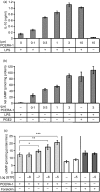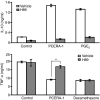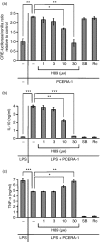The ceramide-1-phosphate analogue PCERA-1 modulates tumour necrosis factor-alpha and interleukin-10 production in macrophages via the cAMP-PKA-CREB pathway in a GTP-dependent manner
- PMID: 19922425
- PMCID: PMC2826682
- DOI: 10.1111/j.1365-2567.2009.03188.x
The ceramide-1-phosphate analogue PCERA-1 modulates tumour necrosis factor-alpha and interleukin-10 production in macrophages via the cAMP-PKA-CREB pathway in a GTP-dependent manner
Abstract
The synthetic phospho-ceramide analogue-1 (PCERA-1) down-regulates production of the pro-inflammatory cytokine tumour necrosis factor-alpha (TNF-alpha) and up-regulates production of the anti-inflammatory cytokine interleukin-10 (IL-10) in lipopolysaccharide (LPS) -stimulated macrophages. We have previously reported that PCERA-1 increases cyclic adenosine monophosphate (cAMP) levels. The objective of this study was to delineate the signalling pathway leading from PCERA-1 via cAMP to modulation of TNF-alpha and IL-10 production. We show here that PCERA-1 elevates intra-cellular cAMP level in a guanosine triphosphate-dependent manner in RAW264.7 macrophages. The cell-permeable dibutyryl cAMP was able to mimic the effects of PCERA-1 on cytokine production, whereas 8-chloro-phenylthio-methyladenosine-cAMP, which specifically activates the exchange protein directly activated by cAMP (EPAC) but not protein kinase A (PKA), failed to mimic PCERA-1 activities. Consistently, the PKA inhibitor H89 efficiently blocked PCERA-1-driven cytokine modulation as well as PCERA-1-stimulated phosphorylation of cAMP response element binding protein (CREB) on Ser-133. Finally, PCERA-1 activated cAMP-responsive transcription of a luciferase reporter, in synergism with the phosphodiesterase (PDE)-4 inhibitor rolipram. Our results suggest that PCERA-1 activates a G(s) protein-coupled receptor, leading to elevation of cAMP, which acts via the PKA-CREB pathway to promote TNF-alpha suppression and IL-10 induction in LPS-stimulated macrophages. Identification of the PCERA-1 receptor is expected to set up a new target for development of novel anti-inflammatory drugs.
Figures






References
-
- Beutler B. Innate immunity: an overview. Mol Immunol. 2004;40:845–59. - PubMed
-
- Szelenyi J, Kiss JP, Puskas E, Szelenyi M, Vizi ES. Contribution of differently localized alpha 2- and beta-adrenoceptors in the modulation of TNF-alpha and IL-10 production in endotoxemic mice. Ann N Y Acad Sci. 2000;917:145–53. - PubMed
-
- Takano M, Nishimura H, Kimura Y, Washizu J, Mokuno Y, Nimura Y, Yoshikai Y. Prostaglandin E2 protects against liver injury after Escherichia coli infection but hampers the resolution of the infection in mice. J Immunol. 1998;161:3019–25. - PubMed
-
- Kast RE. Tumor necrosis factor has positive and negative self regulatory feed back cycles centered around cAMP. Int J Immunopharmacol. 2000;22:1001–6. - PubMed
-
- Zidek Z. Adenosine – cyclic AMP pathways and cytokine expression. Eur Cytokine Netw. 1999;10:319–28. - PubMed
Publication types
MeSH terms
Substances
LinkOut - more resources
Full Text Sources

